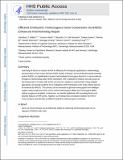| dc.contributor.author | Wilde, Jonathan J | |
| dc.contributor.author | Aida, Tomomi | |
| dc.contributor.author | del Rosario, Ricardo CH | |
| dc.contributor.author | Kaiser, Tobias | |
| dc.contributor.author | Qi, Peimin | |
| dc.contributor.author | Wienisch, Martin | |
| dc.contributor.author | Zhang, Qiangge | |
| dc.contributor.author | Colvin, Steven | |
| dc.contributor.author | Feng, Guoping | |
| dc.date.accessioned | 2022-06-15T17:22:38Z | |
| dc.date.available | 2022-06-15T17:22:38Z | |
| dc.date.issued | 2021 | |
| dc.identifier.uri | https://hdl.handle.net/1721.1/143451 | |
| dc.description.abstract | Searching for factors to improve knockin efficiency for therapeutic applications, biotechnology, and generation of non-human primate models of disease, we found that the strand exchange protein RAD51 can significantly increase Cas9-mediated homozygous knockin in mouse embryos through an interhomolog repair (IHR) mechanism. IHR is a hallmark of meiosis but only occurs at low frequencies in somatic cells, and its occurrence in zygotes is controversial. Using multiple approaches, we provide evidence for an endogenous IHR mechanism in the early embryo that can be enhanced by RAD51. This process can be harnessed to generate homozygotes from wild-type zygotes using exogenous donors and to convert heterozygous alleles into homozygous alleles without exogenous templates. Furthermore, we identify additional IHR-promoting factors and describe features of IHR events. Together, our findings show conclusive evidence for IHR in mouse embryos and describe an efficient method for enhanced gene conversion. | en_US |
| dc.language.iso | en | |
| dc.publisher | Elsevier BV | en_US |
| dc.relation.isversionof | 10.1016/J.CELL.2021.04.035 | en_US |
| dc.rights | Creative Commons Attribution-NonCommercial-NoDerivs License | en_US |
| dc.rights.uri | http://creativecommons.org/licenses/by-nc-nd/4.0/ | en_US |
| dc.source | PMC | en_US |
| dc.title | Efficient embryonic homozygous gene conversion via RAD51-enhanced interhomolog repair | en_US |
| dc.type | Article | en_US |
| dc.identifier.citation | Wilde, Jonathan J, Aida, Tomomi, del Rosario, Ricardo CH, Kaiser, Tobias, Qi, Peimin et al. 2021. "Efficient embryonic homozygous gene conversion via RAD51-enhanced interhomolog repair." Cell, 184 (12). | |
| dc.contributor.department | Massachusetts Institute of Technology. Department of Brain and Cognitive Sciences | |
| dc.contributor.department | McGovern Institute for Brain Research at MIT | |
| dc.relation.journal | Cell | en_US |
| dc.eprint.version | Author's final manuscript | en_US |
| dc.type.uri | http://purl.org/eprint/type/JournalArticle | en_US |
| eprint.status | http://purl.org/eprint/status/PeerReviewed | en_US |
| dc.date.updated | 2022-06-15T17:20:15Z | |
| dspace.orderedauthors | Wilde, JJ; Aida, T; del Rosario, RCH; Kaiser, T; Qi, P; Wienisch, M; Zhang, Q; Colvin, S; Feng, G | en_US |
| dspace.date.submission | 2022-06-15T17:20:17Z | |
| mit.journal.volume | 184 | en_US |
| mit.journal.issue | 12 | en_US |
| mit.license | PUBLISHER_CC | |
| mit.metadata.status | Authority Work and Publication Information Needed | en_US |
